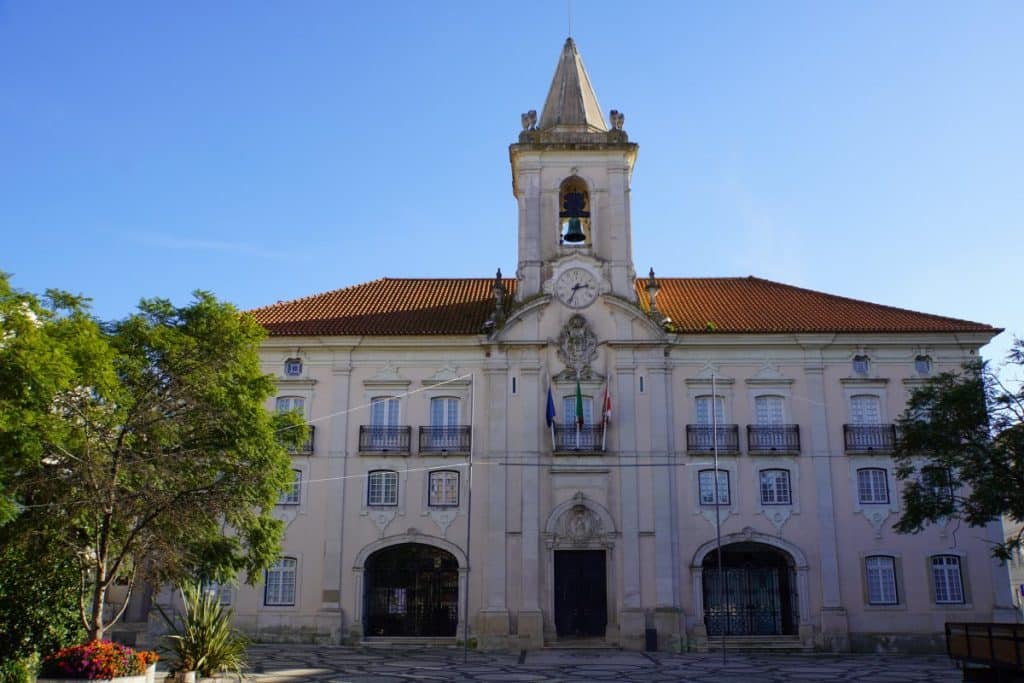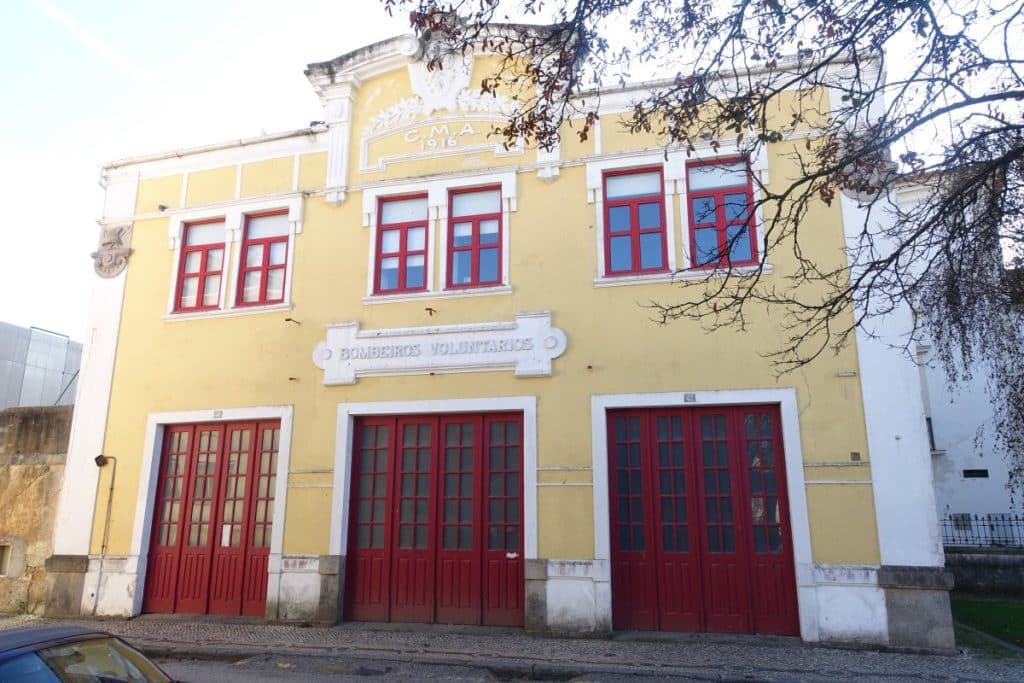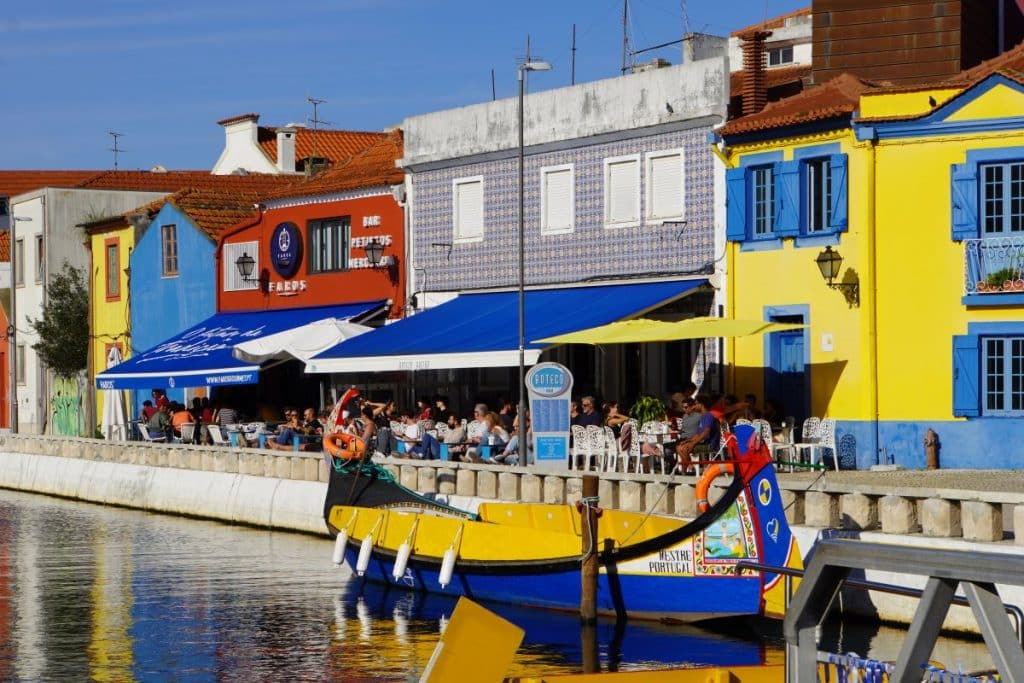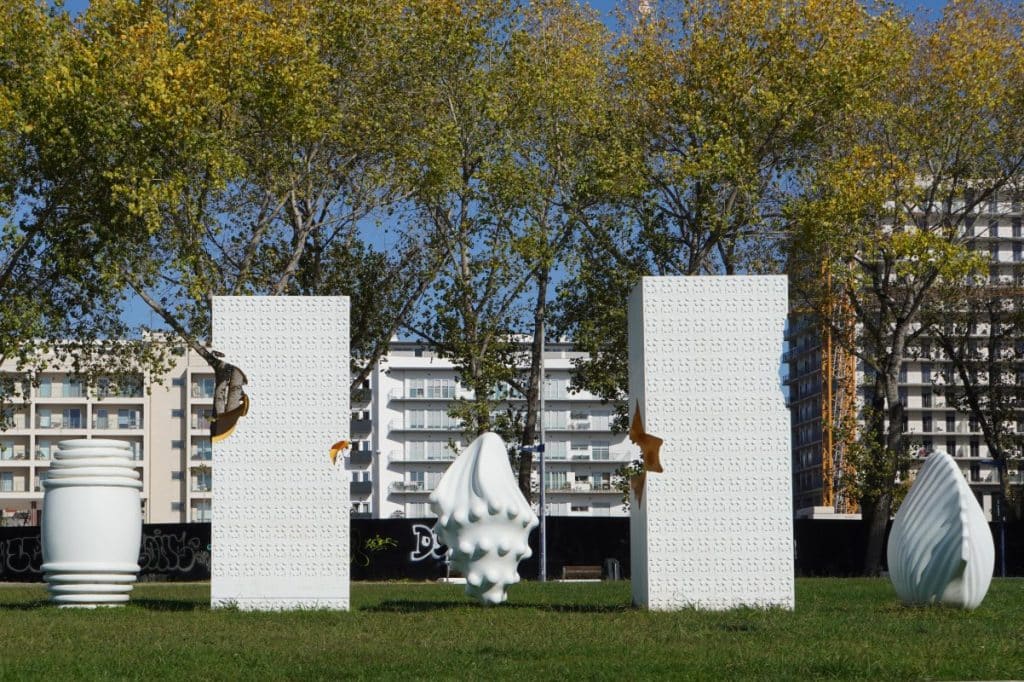“Venice of Portugal” – it just sounds like a place you shouldn’t miss. We took the train to Aveiro for a day trip in beautiful sunshine.
Aveiro is only around 60 kilometres south of Porto, directly on the Atlantic Ocean. A train runs directly from Porto to the beautiful city. The journey is relaxing and I enjoyed looking out of the window and catching a great view of the sea again and again.

A look at the history of Aveiro
The town’s excellent location by the sea was a decisive advantage for its development. Sea trade, fishing and later salt production not only led to a steady increase in the population, but the town also soon became economically significant.

In 1575, the town’s economy collapsed completely unexpectedly when the harbour entrance was so silted up after a major storm that shipping was barely possible. The population tried several times to create a new harbour entrance, but it always turned out to be a futile endeavour. The population fell to around 3,500 by the end of the 18th century.

The Barra Nova was built in the 19th century. This opening to the ocean (1808) made it possible to create a 264 metre-long canal that once again connected the city directly to the sea.
It was not until 1864, with the opening of the railway line from Lisbon to Porto and the construction of a railway station in Aveiro, that economic development in the city began to recover. Industrialisation set in and the population began to grow again. The former economic sectors such as salt extraction and fishing have since lost their importance. Today, the city is surrounded by factories such as Renault and Bosch, as well as paper manufacturing and wood and cork processing companies. The city’s harbour is an important logistics location.

Another economic factor that should not be underestimated today is tourism. The three canals Canal de São Roque, Canal das Pirâmides and Canal dos Santos Mârtires have given the city the nickname “Venice of Portugal” and attract visitors. Admittedly, we also “only” travelled to the city to take a canal tour and were pleasantly surprised at how many beautiful places there were to discover.
Places of interest in Aveiro
The first surprise awaited us at Aveiro railway station. The old railway station building stands right next to the new modern station. Like so many buildings in Portugal, it has been designed with the typical blue and white azulejos to create what I think is an unmistakable work of art.
On the side of the railway tracks you can read the lettering Aveiro. However, I find the design on the city side even more beautiful. Here, the tiles show various motifs relating to Aveiro, for example important people or sights. Today, the old station building is used for art exhibitions.

A wide road leads from the railway station directly into the city. To the right and left of the road are Art Nouveau houses right next to new buildings – a wild architectural mix.
Museum De Santa Joana Aveiro
The Aveiro Museum displays an important collection of works of painting, sculpture, carving, tiling and goldsmithing. It is located in a former Dominican convent. This convent dates back to the second half of the 15th century and from 1472 Princess D. Joana, daughter of King D. Afonso V. The princess, who led a very pious life, was beatified in 1693.

In 1834, Minister Joaquim António de Aguiar ordered the closure of religious orders in the kingdom. This order was immediately implemented in the male convents, but in the female convents, cloistering was permitted until the death of the last nun. The Aveiro Museum was established in the monastery building in 1911.
We particularly liked the architecture with the cloister, the refectory and the church.
Igreja de São João Evangelista
One of the churches that particularly impressed us during our visit to Aveiro is the Carmelite Church on Marquês de Pombal Square.

From the outside, it looks very inconspicuous and the neighbouring former monastery building looks very run-down. Once you step through the door into the church, the picture is completely reversed. I haven’t seen many church naves as impressive as this one.

Construction of the church began in 1704 and was completed over the course of the 18th century. Gilded carvings, tiles, paintings and sculptures wherever you look. I am particularly fascinated by the gilded wood carvings, which can be categorised into three different phases: Proto-Baroque, Johannine Baroque and Rococo. Everywhere on the walls and also on the ceiling, I discover paintings with ecclesiastical motifs framed by the carvings. This is always very unusual for me, even in Portuguese churches there are beautifully crafted blue and white tiles. In the Igreja de São João Evangelista, the walls are decorated with tile paintings up to about the height of the doorposts.


Sé Catedral de Aveiro
Aveiro Cathedral is one of the city’s most important sights. The church was consecrated in 1464 and was originally connected to a convent. In the 17th and 18th centuries, the interior and exterior of the episcopal church were remodelled.
The cathedral’s bell tower is particularly striking. According to current knowledge, it is the oldest part of the church and has an imposing late Baroque façade.

The tiles in the interior are particularly beautiful and show impressive images. In the Capela da Visitação, you can admire a magnificent reredos from 1559 depicting the Virgin and St Elizabeth.
What you should not miss
When strolling through the alleyways and streets of the city, there is always a surprise. From impressive tile work on various walls to beautiful old houses.

You pass a wide variety of squares, such as the large square in front of the town hall with its large monument or the square in front of the Tribunal de Comarca – Aveiro. In a building that at first glance does not fit into the city at all.


Not to be overlooked are the countless very different bridges over the canals. Whether traditional or super modern. In any case, they shorten the routes in the city.


You shouldn’t miss the salt works of the Ecomuseum Marinha da Troncalhada. When we were there, they were completely flooded and we could only recognise a few walls of the individual fields. Unfortunately, it was not possible for us to walk between the fields and take a closer look at the salt production process, which is explained on the signs. Nevertheless, we took some salt with us. A small house very close to the salt works sells “salty” products. The fleur de sal is really good and very flavourful.

Highlight of a visit to Aveiro: a ride on the Moliceiro
Anyone coming to Aveiro is sure to take a trip on the colourful fishing boats, the moliceiro. The urban area is intersected by canals, which give the cityscape an inimitable charm.

You can’t miss the departure points of the colourful boats, you’re just spoilt for choice as to which one you’d like to go on. The tours and prices are identical for all providers, only the colour of the boats is different. It felt like we walked past all the providers three times until I found the ticket seller I liked best.

We were the first participants on the next tour and were able to choose a seat on the boat. Later, the crew seated the other passengers on the benches attached to the side of the boat. The “guide” walked back and forth in the centre of the Moliceiro during the entire trip, telling stories about the city and the people in 4 languages, and I would say he also spun a few yarns.
The journey takes about 45 minutes. However, if you are expecting a gondolier poking his pole like in Venice, you will be disappointed. The engines are still rattling here, but it should soon be much quieter, as a regulation provides for the use of electric motors.

Mir hat die Tour sehr gefallen. Bei wunderschönem Wetter über die Kanäle zu fahren und dabei den Blick auf die Stadt genießen. Da kommt schon Urlaubsfeeling und Erholung auf. Die Eindrücke sind sehr vielfältig. Vom Jugendstilgebäude bis zum modernen Hotelbau, vom alten Fabrikgelände bis zur Fischhalle war wirklich alles dabei, was man in einer Stadt erwartet. Besonders schön fand ich die vielen kleinen Brücken, die mit bunten Bändern als Liebesbeteuerung von Paaren geschmückt sind.

An einer Stelle fuhren wir an einer Skulptur der für Aveiro berühmten Ovos Moles vorbei, die uns daran erinnerte, die Spezialität des Ortes noch zu probieren.

Oves Moles – the soft eggs from Aveiro
Oves Moles from Aveiro are famous the world over. We couldn’t go past the traditional dessert on our day trip to the city. We bought some in a small shop near the departure point of the small sightseeing boats.

Legend has it that a nun invented the dessert to circumvent the fasting requirement. Wafers are used, which enclose the Doce de ovos moles cream. This cream consists mainly of sugar and egg yolk. To make the small pastries look good, they are presented in the form of seafood (mussels, snails).

Firstly, we opened a “shell” to see what was hidden inside. What emerged was a not particularly appetising-looking mass that looked a lot like egg yolk, but was a little firmer in consistency. Of course, we also tasted it and to be honest, there are better things. The mixture tastes sweet, like egg, sweet and sweet… Even the wafer couldn’t do anything about it, the flavour is very special. We won’t be making a second purchase.

Is the trip to Aveiro worth it?
Wir hatten auf jeden Fall eine tolle Zeit in Aveiro. Die Hin- und Rückfahrt mit dem Zug verlief vollkommen problemlos und war auch nicht teuer. Der Stadtbummel offenbarte einige wunderschöne Orte und auch die zugegebener Maßen touristische Fahrt mit den Moliceiro hat uns sehr gefallen.
A wonderful day trip!


Leave a Reply